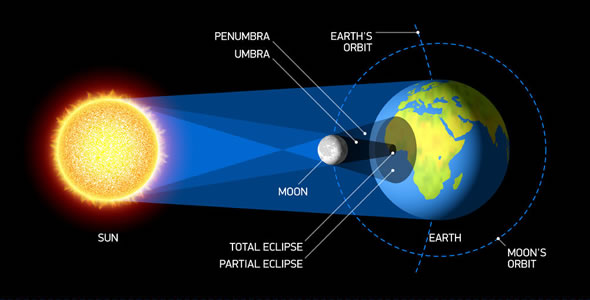Total Solar Eclipse Aug. 21; Hawai‘i Partial Eclipse Begins at Dawn
The “Great American Eclipse,” the first total solar eclipse to cross North American since 1918, will occur on Monday, Aug. 21, 2017, from approximately 10:22 a.m. in Oregon to 11:50 a.m. in Nebraska.
The maximum partial eclipse in Hawai‘i can be viewed at approximately 6:35 a.m. HST (6:05 a.m. in Hilo).
Shadia Rifai Habbal, a UH Mānoa Institute for Astronomy astronomer and eclipse expert is leading an international scientific team observing the total eclipse from five different sites across the U.S. to collect data to aid in answering some of science’s biggest questions.
“To witness the event, when you are going from full daylight to nighttime, well it happens over an hour, but the last bit is very very quick and all of sudden you are immersed in darkness and you see this bright corona shimmering in the sky, is something very, very unique,” said Habbal.
Habbal and team are using custom-built spectrometers to measure the solar wind and magnetic waves of the sun’s corona, which they can only do during a total solar eclipse.
“One of the big puzzles about the sun is the surface temperature is about 6,000 degrees,” Habbal said. “But then when you get to the corona it is several million. So what is causing the temperature to go up so suddenly?”
Habal said that solar wind and magnetic wave research “tells us something about the whole universe and the formation of solar systems, so it’s a very profound idea and concept that we’re exploring.”
She and her team, the Solar Sherpas, have observed 14 solar eclipses since 1995.
More information about Habbal and her team is available online.
How Hawai‘i Can View the Total Solar Eclipse
The public can safely view the solar eclipse in Hilo or online through a UH Hilo YouTube broadcast from UH Hilo Instructor John Hamilton and Lecturer Marc Roberts, who will be observing the eclipse from the Lost River Field Station near Mackay, Idaho, one of the official NASA viewing sites.
The link will go live on Aug. 21, 2017, at 6:30 a.m. HST.
UH Hilo’s astronomy department has planned an event hosted by Associate Professor Heather Kaluna to view the eclipse via live feed at the Science and Technology Building on the UH Hilo campus starting at 6 a.m.
For those unable to attend the UH Hilo event, the Maunakea Observatories Astronomy Outreach Committee will also broadcast the UH Hilo feed live on their website.
Viewing Advice from the Bernice Pauahi Bishop Museum
- IT IS NEVER, EVER SAFE TO VIEW A PARTIAL SOLAR ECLIPSE DIRECTLY.
- The best bet for safely viewing a partial eclipse: purchase inexpensive safe viewing glasses carried by Bishop Museum’s Shop Pacifica. THE GLASS ARE SOLD OUT, HOWEVER.
- Improvised solar viewing techniques such as using a certain level of welder’s glass, a smoked mirror, etc. are NOT TO BE USED since they are not designed to protect the eyes from viewing the sun.
- If you are not able to get the safe viewing glasses, click here to find instructions on how to make a pinhole viewer. Note that these homemade devices are not as effective as eclipse viewers.
- Bishop Museum on O‘ahu will NOT be hosting an eclipse event early on Aug. 21.
- However, this is a good do-it-yourself viewing event:
- Make sure you have a flat eastern horizon to see the eclipse; looking over the ocean is ideal. The sun will rise in the ENE.
- Chose a location where there is a good chance of clear skies—check the forecast that morning.
- There will NOT be a noticeable drop in brightness during the partial eclipse; in fact, unless you are viewing the sun via a safe filter, you would not be aware that there was anything unusual that morning with the sun.
Viewing the eclipse elsewhere in the islands (i.e. outside of Honolulu)
- The main variable in terms of this eclipse in the Hawaiian Islands is that the sunrise time varies depending on how far east a given location is; the further east you are, the earlier your sunrise. Thus, in Hilo, for example, the sun will rise in eclipse at 6:05 a.m., 10 minutes earlier than in Honolulu.
- Except for this sunrise variation, the timing for the eclipse is pretty much the same throughout the islands, with the sun rising already in eclipse and the event ending throughout the islands around 7:25 a.m.
BigIslandNow.com is simply passing on information provided by experts and is in no way responsible for injuries caused by following these instructions, either correctly or incorrectly.
















